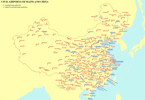Houses, tires, chemicals and trees washed to sea by the March 11 tsunami in Japan will float across the Pacific and eventually hit first Hawaii and eventually the U.S.West coast.
The predictions of U.S. oceanographer Curtis Ebbesmeyer is expecting human feet, still in their shoes, to wash up.
‘I’m expecting parts of houses, whole boats and feet in sneakers to wash up,’ Mr Ebbesmeyer, a Seattle oceanographer who has spent decades tracking flotsam said.
Several thousand bodies were washed out to sea following the disaster and while most of the limbs will come apart and break down in the water, feet encased in shoes will float, Mr Ebbesmeyer said.
‘I’m expecting the unexpected,’ he added.
Members of the U.S. Navy’s 7th fleet, who spotted the extraordinary floating rubbish, say they have never seen anything like it and are warning the debris now poses a threat to shipping traffic.
The State of Hawaii may get a new and unwelcome addition in coming months — a giant new island of debris floating in from Japan.
Researchers in Hawaii have created a simulation showing exactly how Japanese tsunami waste will float across the Pacific and eventually hit the U.S. coast.
The team, led by Nikolai Maximenko and Jan Hafner at the International Pacific Research Center of the University of Hawaii at Manoa have spent years preparing computer models by following real world observations of floating buoys, according to a statement.
The first wave should begin washing up on beaches in Hawaii within a year, the simulation shows.
After it passes Hawaii it should begin hitting beaches stretching from Vancouver down through Oregon, Washington and to the tip of Baja California in 2014, before bouncing back toward Hawaii for a second impact.
That second impact five years from now could be even more concentrated and harmful to Hawaii’s beaches and reefs, the researchers found.
The flotsam and trash eventually makes its way into what’s called the North Pacific Garbage Patch, a sort of circulating whirlpool of garbage hundreds of miles in diameter.
There it eventually decomposes and breaks up in collisions over many years.
WHAT TO TAKE AWAY FROM THIS ARTICLE:
- The team, led by Nikolai Maximenko and Jan Hafner at the International Pacific Research Center of the University of Hawaii at Manoa have spent years preparing computer models by following real world observations of floating buoys, according to a statement.
- Several thousand bodies were washed out to sea following the disaster and while most of the limbs will come apart and break down in the water, feet encased in shoes will float, Mr Ebbesmeyer said.
- Houses, tires, chemicals and trees washed to sea by the March 11 tsunami in Japan will float across the Pacific and eventually hit first Hawaii and eventually the U.






















